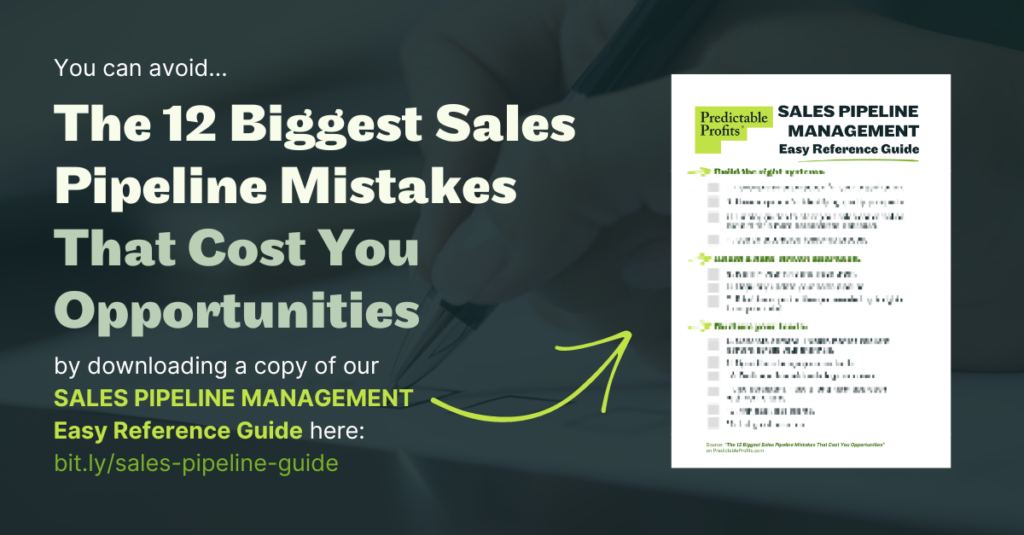What are the most common sales pipeline mistakes that keep you from growing your business? We’ve identified 12 of these in our latest blog post.
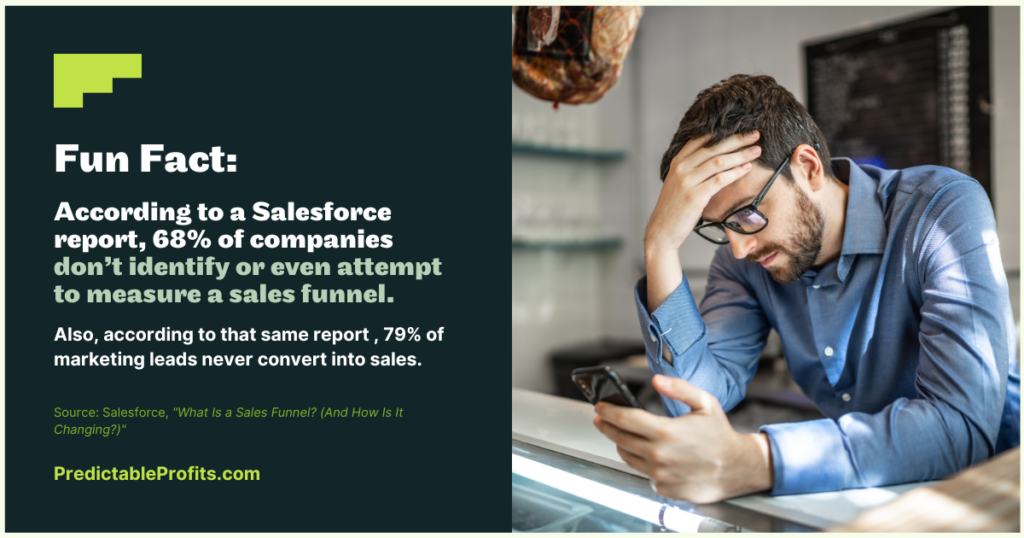
For entrepreneurs and business owners, keeping track of prospects, leads, and opportunities is essential for success.
The sales pipeline is a valuable tool for organizing this information and ensuring everything runs smoothly.
A strong sales funnel leads to increased growth. Yet, according to a Salesforce report:
- 68% of companies don’t identify or attempt to measure a sales funnel.
- 79% of marketing leads never convert into sales.
That’s clearly a LOT of wasted opportunities!
In the beginning, you, as the business owner, are responsible for bringing in sales. However, maintaining and managing your sales pipeline becomes more challenging as your organization grows.
Since your sales process involves many moving parts, sales pipeline mistakes impact opportunities that can directly affect your business’s profitability and growth.
Sales pipelines are essential because they track sales progress and identify improvement areas.
Yet, in our experience, they’re also a source of several common errors. The three biggest sales pipeline mistakes we see include not having proper systems, not adequately nurturing leads, and not tracking data.
This blog post discusses these mistakes and how to correct them.
So let’s dive in!
You Undermine Your Sales Pipeline Without the Right Systems
Your sales pipeline is a perfect example of why you need proper systems to scale your sales efforts as your business grows.
The key is to systemize your sales pipeline so anyone with average experience can step in and deliver an above-average result.
Remember: Systems allow you to replicate your successes and make consistent progress even when you’re not around. They allow you to drive growth without the company being too dependent on you.
Check out our related article, “How to Create a Self-Growing Business (With Systems).”
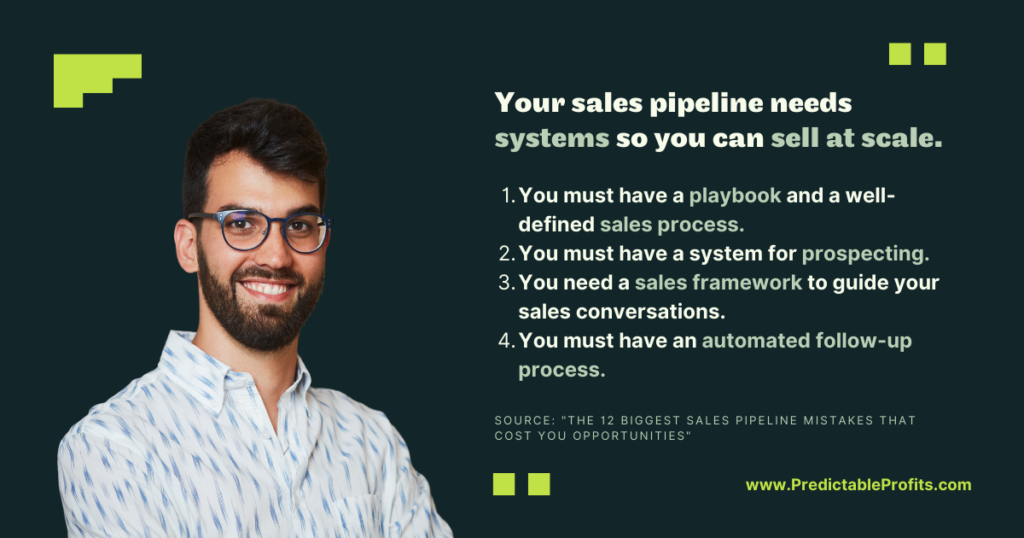
Here are several sales pipeline mistakes that happen without adequate systemization:
1. You don't have a well-defined sales process.
Your sales pipeline needs all its bases covered to be a truly valuable resource. Specifically:
- It must be visible, so it’s not forgotten about by those who need it.
- It must be updated consistently with new information about prospects/customers.
- It must be accessible at any time.
Unfortunately, according to Linkedin Business, these “musts” often don’t happen. As a result, an estimated 24% of forecasted deals go dark.
What accounts for these lost opportunities?
- Decision-makers typically change roles at a rate of 20% per year (account churn).
- An estimated 25% of sales reps change roles every year (internal churn).
- Reps spend 37.2% of their time on non-core activities (a lack of focus).
And this is why a sales playbook is so helpful — because it helps define your sales process.
In a dynamic digital environment, the sales pipeline is constantly in flux. A sales playbook with flowcharts and frameworks can eliminate guesswork for your sales team. So they can focus on delivering results without having to wing it.
You might be making a critical mistake in your sales pipeline if you struggle to close deals and meet your sales targets. In this video, Zach and CJ reveal the #1 sales pipeline mistake that could cost you business.
For more, check out our related article, “7 Steps for Building Your Sales Playbook.”
2. You don’t have a system for prospecting.
How you qualify leads impacts your sales pipeline’s health.
Research shows that 37% of marketers consider prospecting the most challenging part of their job. Qualifying your prospects is essential in building a sales pipeline because
- It allows you to focus on leads with higher prospects of buying.
- It helps with a focused selling experience.
- It aids in developing more customized solutions.
- It lets you identify multiple opportunities for revenue generation.
- It establishes different sales qualification processes.

Remember, quality is more important than the number of prospects in your pipeline.
Here are five of the most common frameworks for qualifying leads:
- BANT – budget, purchasing authority, need, and timing
- MEDDIC- metrics, economic buyer, decision criteria, decision process. identifies pain, champion
- ANUM – authority, need, urgency, and money
- CHAMP – challenge, authority, money, and prioritization
- GPCTBA/C&I – goal, plan, challenges, timeline, budget, authority, negative consequences, and positive implications (C&I)
Are you struggling to build a consistent pipeline of leads for your business? In this video, Zach and CJ explore the essential elements of a winning prospecting system.
For more on prospecting, check out this related blog post, “Outbound Prospecting Tips For Prospects Not Ready To Buy.”
3. You use a cookie-cutter approach to sales.
According to a Gartner report, consumers do 60% of their research before landing on your website. This means they likely know you and your competition.
Regarding your sales pipeline, take time with each individual. Tailor your message to their needs and interests so they feel valued throughout this process- from reaching out via email or phone call all the way through closing a deal.
How?
- Use all data sources to gather information about your prospect.
- Start a real conversation and show genuine interest.
- Employ a lead qualification framework. Use this to Zero in on their pain points, resource constraints, and other challenges.
- Leverage your data to create the ideal message in as many touchpoints as possible.
You should have guides and templates for steering your sales conversations, but still take time to personalize your messages and build relationships.
As many as 68% of B2B customers are lost because of indifference or perceived apathy, not because of mistakes. (Gallup)
4. You don't have an automated follow-up process.

Remember, most leads don’t buy right away. So keep reaching out, especially after a meeting.
The Brevet Group reports that 80% of sales require five follow-up calls after a meeting. Yet 44% of sales reps give up after only one follow-up!
So leverage your CRM software’s marketing automation to do the follow-up for you.
- Segment your prospects into high-value accounts, high-velocity accounts, small accounts, etc.
- Personalize your messages.
- Add value with case studies, blog posts, demos, and more.
Are you frustrated by the number of valuable leads slipping through your fingers? It’s time to take action and stop losing out on potential sales. In this video, Zach and CJ share practical advice for engaging your leads and moving through the sales pipeline.
Not Having a Data-Driven Approach
With a data-driven sales pipeline, teams collect and analyze customer information to make smarter, more informed decisions.
This allows you to craft more personalized messages, optimize your pipeline, and see trends and patterns among your leads and prospects.
Today, teams can gain a competitive edge by using data visualization platforms to reveal insights that can improve campaigns, maximize customer lifetime value, or facilitate coaching and mentoring.
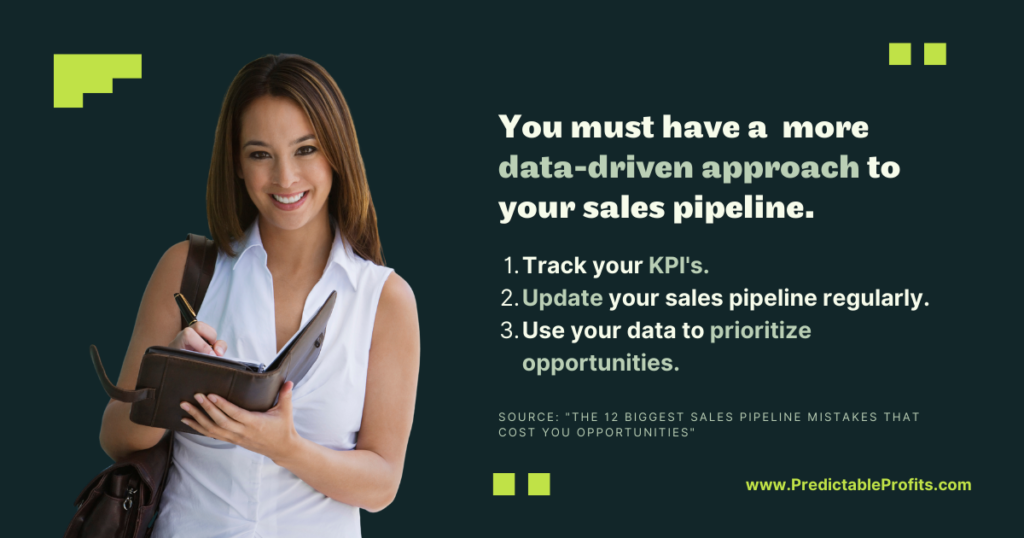
Here are the usual sales pipeline mistakes that happen if you don’t take a data-driven approach seriously:
5. You don’t track your KPIs.
Tony Robbins reminds us that “success leaves clues.” So if you don’t track your sales team’s key performance indicators, everything you do is just a shot in the dark.
Tracking KPIs within your sales funnel…
- Removes guesswork because you see what works.
- Allows you to identify areas in your sales process that need attention or improvement.
At a minimum, you should monitor your sales revenue, lead flow, and customer lifetime value.
Other KPIs worth tracking include:
- Average deal size
- Average sales cycle length
- Pipeline conversion rate
- Customer acquisition cost
- Revenue growth
- Win rate
- Sales velocity
There’s an old saying, “What gets measured, gets managed. And what gets managed gets improved.” This definitely applies to tracking your KPIs.
6. You don’t update your sales pipeline.
The key to sales success is having the right data on your deals.
Changes constantly happen within your sales pipeline, so it is vital that you keep your data updated.
- Keep your leads’ contact information current.
- Note buyer intent (i.e., where they are in the buyer’s journey)
- Monitor behaviors such as website visits, media consumption, inquiries, etc.
- Profile your leads based on their current software stack, technology usage behavior, software adoption, etc.
- Add notes that can help with sales conversation down the road.
Constant updating does requires quite a bit of effort, but if the time is spent to weed out dead leads or update otherwise outdated information, your actions help make a healthier, more robust sales pipeline.
7. You don’t use data to prioritize opportunities.
Failing to prioritize sales opportunities leads to negative impacts on revenue and even loss of potential customers.
At the core of effective prioritization is looking at each opportunity through both a quantitative and qualitative lens:
- On the quantitative side, this is where key metrics come in. You can prioritize your leads based on the likelihood of closing or conversion rates by using history or other trends/patterns.
- On the qualitative side, look at customer intent, preference for certain offers, and strength of your client relationships.
The idea is to make your sales as frictionless as possible, especially as opportunities present themselves.
Remember, B2B buyers are 57% of the way to a buying decision before engaging with sales (Source: CEB).
So when they reach out to your sales team, quickly identify the opportunity and act accordingly.

Not Taking Your Lead-Nurturing Efforts Seriously
Lead nurturing, when done right, drives prospects closer to purchase, even those who aren’t (immediately) interested in your offer.
However, many companies overlook lead nurturing, relying instead on word-of-mouth or referrals to fill the sales pipeline.
A strong lead-nurturing strategy “pre-heats” your leads in ways that drive awareness and create engagement.
Lead nurturing should be your #1 priority once your sales pipeline is in place. Yet only 69% of marketers view converting leads into customers as a top objective. (Hubspot)
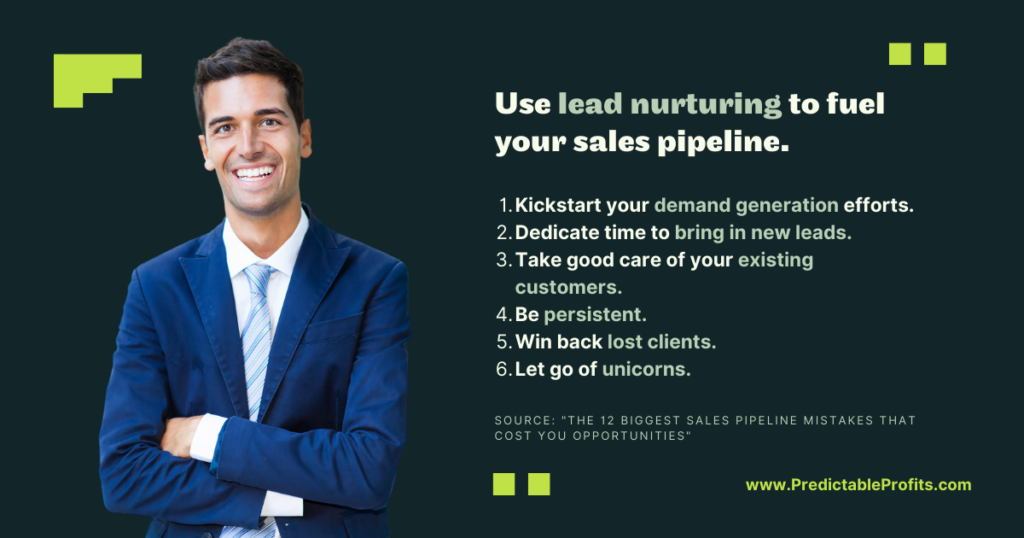
Here are the most common sales pipeline mistakes regarding lead nurturing:
8. You don’t generate enough demand.
A strong demand-generation strategy shares quality content with as many people as possible (and as freely as possible).
According to our research, 7.5% of marketing-qualified leads (people early in the buying process) will do business with you within the first 90 days.
But here’s the kicker:
An additional 42.5% of those marketing-qualified leads will do business between 90 days and two years from now.
So what can you do to kickstart your demand-generation efforts?
Continue publishing helpful, market-relevant content across your channels — via your blog, email, social media, video, virtual events, online ads, downloadables, etc.
- Understand your buyer’s journey and create content for them at every stage.
- Go for that “I see you everywhere” reaction by embracing an omnichannel approach to your content marketing and brand-building efforts.
- Use your Unique Advantage Points to bring more value.
- Build out revenue-generating strategies so you’re not dependent on only referrals or word-of-mouth marketing.
- Leverage social selling to stay top-of-mind and be seen as an authority in your space.
- Have a more systematic approach to following up on your leads.
- Provide solutions and fresh perspectives to give your customers much-needed “a-ha!” moments.
Check out our related piece,”[LIVE Sessions] Demand Generation: How to Fill Your Sales Pipeline (in 2022).”
9. You don’t spend enough time bringing in new leads.
To find new customers, set a time each day or week dedicated to prospecting.
Fun fact: Email is almost 40 times better at acquiring new customers than Facebook and Twitter. (Brevet.)
By consistently setting aside some uninterrupted personal/work hours in your schedule every single session without fail- of course, depending on how big an area represents potential buyers- you will start seeing results immediately.
10. You neglect your existing customers.
Acquiring new customers is vital to a growing business and for retaining a big pipeline, but not at the expense of current clientele.
While a healthy mindset toward boosting sales can cause mistakes, focusing solely on numbers — such as your amount of qualified leads — can lead to obsession with figures.
Remember, retaining current customers is 6-7 times less costly than acquiring new ones, especially those high-quality prospects who made previous purchases.
Attend to leads in your pipeline by sharing new and helpful information via email blasts, blog posts, or social media.
Engaging your customers is an opportunity for you to increase the amount they spend and introduce them to other products.
Managing accounts, up-selling or cross-selling can help ensure this positive relationship continues while also increasing profits in ways like introducing new offerings not yet offered by competitors!

11. You’re not persistent enough.
Here’s a fun fact: 44% of salespeople give up after just one rejection. That’s well below the average of five attempts needed to make a sale.
- 44% of salespeople give up after one “no.”
- 22% give up after two “nos.”
- 14% give up after three “nos.”
- 12% give up after four “nos.”
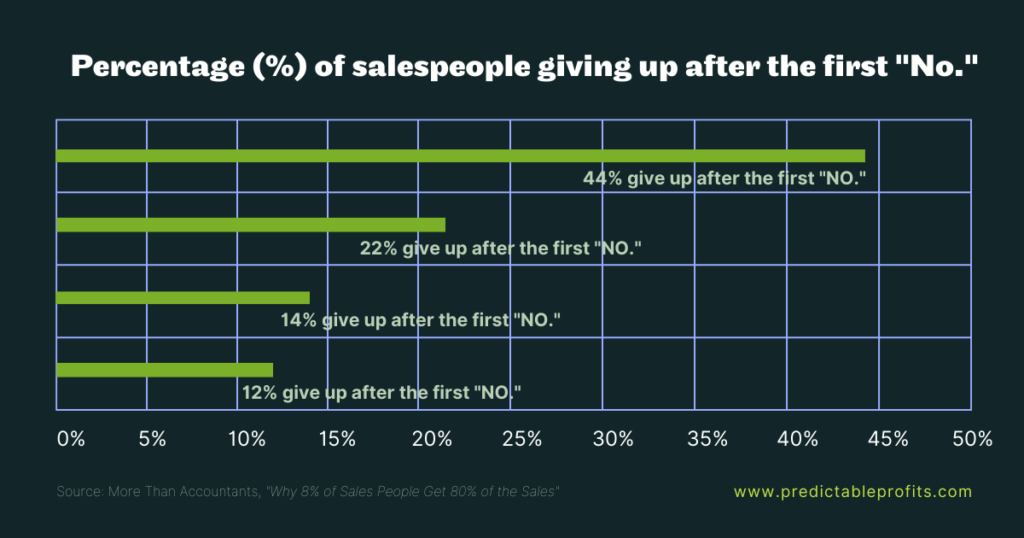
Following up on your interactions is a great way to get new customers and create a well-stocked sales funnel.
Sales take time. So don’t just focus on prospects ready to buy right now. Take a long-term approach too, and you’ll unlock new sales opportunities.
12. You don’t win back lost clients.
Let’s face it, you could have the world’s best product or service. But a portion of your clients eventually stop doing business with you, no matter how good you are.
Here’s the good news: 80% of the time, you can bring back your disengaged clients with the right communication, strategy, and offer.
So you should always have a system for retargeting and bringing back lost clients (i.e., a customer re-engagement strategy).
- Communicate with your prospects and clients regularly to stay top-of-mind.
- Automate your CRM so that if a regular customer stops doing business with you, it triggers a pre-planned sequence inviting them back.
In our experience, running a customer re-engagement strategy can get you back around 30% of your lost buyers. This is one of the most effective ways to immediately impact your bottom line.
13. You chase unicorns. (Bonus tip)
As a business owner or a sales manager running a sales team, you often encounter the elusive “big deal” that’s about to close “sometime soon.”
Sure, some companies have longer sales cycles than others. And many of these opportunities pay off with pig-headed determination. But how often do you have reps who waste time by going after something that will never close?
A LinkedIn Business article recommends that, as a sales manager, you should always ask clarifying questions to avoid this trap of chasing unicorns.
Specifically, questions such as:
- “What actions have the customer taken since you last spoke?”
- “Who else needs to be involved in order to move this deal forward?”
- “Have they ever done anything like this before?”
- “What would cause them to act now when they haven’t in the past?”
Asking these tough questions now forces your reps to re-evaluate prospects, so they don’t make unproductive calls.
Download This: Sales Pipeline Management Easy Reference Guide
To help you get your sales pipeline in order, we’ve put together a handy resource for your convenience: a Sales Pipeline Management Easy Reference Guide, available for you to download as a PDF.
Click on the image above or this link to download your PDF copy.
Conclusion: A Final Word on Sales Pipeline Mistakes
Pipeline problems can be costly and frustrating for businesses of all sizes, but most especially if you’re a growing company.
You can fix many of these sales pipeline mistakes by simply leveraging systems, using a more data-driven approach, and employing a smarter lead-nurturing process.
Be part of our ever-growing community of seven- and eight-figure business owners:
- Check us out on the Predictable Profits YouTube channel.
- Connect with us on Linkedin.
- Join other entrepreneurs (like yourself) on our Facebook page.
- And if you haven’t already, sign up for our daily business coaching video series (by entering your email address below).

